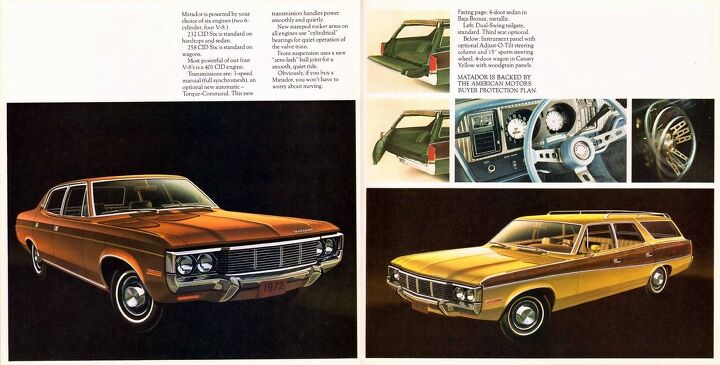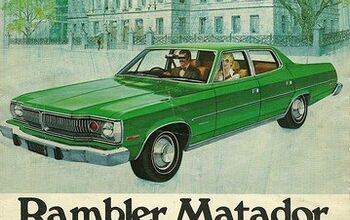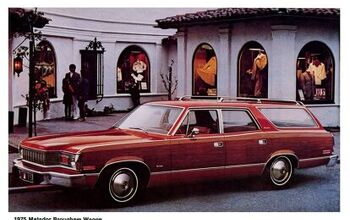Rare Rides Icons: The AMC Matador, Medium, Large, and Personal (Part I)

The American Motors Matador line was many things to many people during its run from 1971 to 1978. Built domestically and abroad, Matadors occupied more than one size class, a broad range of price points, and were even dressed in fashionable luxury garb for a while. Come along as we explore the world of Matador.
Like most “new” AMC vehicles, the Matador wasn’t a new car at its debut for the 1971 model year. Underneath, it was a refreshed and renamed version of AMC’s Rebel (1967-1970). The fresh identity for the model was part of a socially conscious strategy change: There was a considerable amount of social unrest and rioting across the United States in the late Sixties, and AMC management decided it wasn’t the best idea for their car to say Rebel on the back. Marketing scientists conducted research and ultimately used a consumer clinic to pick out a new, more acceptable name: Matador. U.S. consumers thought the word sounded exciting and virile. Hey, whatever gets you going. The Matador name didn’t go over as well in the Puerto Rican market, where the word had a strong association with killing and bullfighting.
Considered a midsize (called intermediate at the time), the ’71 Matador shared its platform with AMC’s full-size Ambassador. Matador had a slightly shorter wheelbase, 118 inches over the Ambassador’s 122. Matador’s overall length was between 205 inches for the wagon and 206 for coupe and sedan, while Ambassadors were at 210.8 inches by 1971, and expanded in length to 212.8 inches for 1973.
Available body styles included a two-door hardtop coupe and four-door versions as sedan and wagon. Though the wagon was the shorty of the group, it had three more inches in height; 56.4 inches versus 53.8 for the other two body styles. Much of the trim in 1971 was a carryover from the Rambler, and knowledgeable buyers would note almost all chrome was 1970 garnish. Bumpers, headlamps, dashboards, and gauges were new that year.
AMC offered a range of engines on its first Matador, like most of its models. The smallest of the group was a 232 cubic inch (3.8L) inline-six, with a 258 (4.2L) inline-six as a one-better that was standard on the wagon. The other three engines were V8s, of 304 (5.0L), 360 (5.9L), and 401 (6.6L) displacements. Transmissions were varied and different in 1971 than the other two production years of the first generation. In its debut year, there was a four-speed manual (on the floor), three-speed manual (on the tree), or three-speed Shift-Command automatic. The following two years used either the three-speed manual or three-speed Torque-Command auto. The latter was a rebrand of Chrysler’s TorqueFlite after AMC replaced the BorgWarner-sourced Shift-Command.
The first Matador lineup was targeted specifically at the midsize family car buyer. AMC sold a lot of Matadors as fleet vehicles too, with four-door versions used in commercial applications and as taxis. US government agencies and police also liked the Matadors, as their powerful V8 engines could outperform most standard vehicles of the day. The heavy-duty police package Matador was offered from 1971 through 1975 before it was discontinued, and most often was fitted with the 360 V8.
Optional on wagon versions was a rear-facing third-row seat that increased people capacity from six to eight. The tailgate on the wagon was two-way: It opened out as a standard barn door or folded down like a tailgate when the rear window was dropped. Also optional was a new Machine Go equipment package, as a replacement for the Rebel The Machine. Muscle cars were on the way out by 1971, as emissions and unleaded gasoline combined with steep insurance rates to make them less appealing. Machine Go was an option rather than its own model like the Rebel The Machine and was offered only on the two-door hardtop. Though performance pieces were included or available on the Machine Go package, the garish American theming of the year before was too “muscle car” in its looks, and not offered. Not a popular package, only 50 Machine Gos were sold in 1971.
There were limited visual changes in 1972, though the grille was simplified. Cars had less bling this year, as chrome at the trunk and rear end that was from the 1970 Rebel was deleted. Rear lamps were new, but gauges regressed to those of the 1967 Rebel. Tuning on the three V8s meant different power levels were available in 1972. Horsepower figures were rated 150, 175, 195, 220, or 255. Notably, V8 engines mandated a three-speed automatic. Marketing changed this year, as AMC introduced a new Buyer Protection Plan per changing consumer tastes. A first across all automakers, the BPP was a factory 12-month, 12,000-mile bumper-to-bumper warranty. AMC promised to repair anything wrong with their car aside from the tires, had a toll-free warranty number, and offered a dealer loaner for overnight repairs.
To lessen the claims on their new all-inclusive warranty, AMC began pushing toward better component suppliers, improving factory production quality at Kenosha, and cutting the number of different models overall. Standard equipment increased to improve streamlining efforts. The warranty and other changes pleased dealers, who were able to use BPP as a sales tool that made AMC stand out from other manufacturers. In its second year, AMC moved 7, 306 Matador coupes, 10,448 wagons, and 36,899 sedans.
1973 was the last for the first-gen Matador, and evidence of the streamlining undertaken in 1972 appeared: All three body styles were available in a single trim for 1973, which was better equipped than before. Visually notable, all ’73 models complied with new NHTSA five-mph bumper regulations. Bumpers were chunkier and more substantial and gained front rubber shock absorbers. At the rear, optional chromed bumper guards of 1972 became rubber, and standard in ’73. Once more, the grille and tail lamps were revised for the annual refresh. One of the last signs of its Rebel history, the bullseye logo on the horn pad disappeared in 1973. Wagons gained a new vinyl upholstery called Uganda this year. By this time almost all I6-powered Matadors had the automatic transmission, as the station wagon was the only one built with an inline-six and a manual transmission.
Marketing took on a racier edge in 1973, as AMC sent the Matador to NASCAR. A two-door hardtop was driven by Mark Donohue (1937-1975). In January 1973 the racing Matador lapped every car in the race and won at the Cup Series. It won again at the Winston Western 500. All the while, AMC was watching ownership surveys to see if their changes made any difference since the Rebel. They had, and Popular Mechanics indicated Matador owners in 1973 were happier and had fewer problems than Rebel owners of 1970.
But the NASCAR and favorable consumer experience weren’t enough, and reviews of the day indicated that although AMC’s product was right where it should be, consumer awareness was not. As evidence, the two-door Matador hardtop was the brand’s slowest-selling model, when such a body style was typically the most popular, most profitable offering in the midsize car market of the day. After three (refreshed) model years, it was time for a rethink on Matador. In particular, AMC wanted to pay more attention to the Matador coupe. More on that in Part II.
[Images: AMC]

Interested in lots of cars and their various historical contexts. Started writing articles for TTAC in late 2016, when my first posts were QOTDs. From there I started a few new series like Rare Rides, Buy/Drive/Burn, Abandoned History, and most recently Rare Rides Icons. Operating from a home base in Cincinnati, Ohio, a relative auto journalist dead zone. Many of my articles are prompted by something I'll see on social media that sparks my interest and causes me to research. Finding articles and information from the early days of the internet and beyond that covers the little details lost to time: trim packages, color and wheel choices, interior fabrics. Beyond those, I'm fascinated by automotive industry experiments, both failures and successes. Lately I've taken an interest in AI, and generating "what if" type images for car models long dead. Reincarnating a modern Toyota Paseo, Lincoln Mark IX, or Isuzu Trooper through a text prompt is fun. Fun to post them on Twitter too, and watch people overreact. To that end, the social media I use most is Twitter, @CoreyLewis86. I also contribute pieces for Forbes Wheels and Forbes Home.
More by Corey Lewis
Latest Car Reviews
Read moreLatest Product Reviews
Read moreRecent Comments
- Calrson Fan Jeff - Agree with what you said. I think currently an EV pick-up could work in a commercial/fleet application. As someone on this site stated, w/current tech. battery vehicles just do not scale well. EBFlex - No one wanted to hate the Cyber Truck more than me but I can't ignore all the new technology and innovative thinking that went into it. There is a lot I like about it. GM, Ford & Ram should incorporate some it's design cues into their ICE trucks.
- Michael S6 Very confusing if the move is permanent or temporary.
- Jrhurren Worked in Detroit 18 years, live 20 minutes away. Ren Cen is a gem, but a very terrible design inside. I’m surprised GM stuck it out as long as they did there.
- Carson D I thought that this was going to be a comparison of BFGoodrich's different truck tires.
- Tassos Jong-iL North Korea is saving pokemon cards and amibos to buy GM in 10 years, we hope.







































Comments
Join the conversation
I have seen a youtube video of the Ramble Ranch looks like a great place to visit. I believe they also sell AMC parts to collectors looking for parts for their Nashes, Ramblers, and AMCs.
Major reason to never buy some dumb Toyota? The continuing stupid already-playing video ad for the world's newest and ugliest V6 pickup truck, foisted off on TTAC readers to make a $1.29 a day extra for the overlords at Torstar. Customer service? What's that? Those readers are just there to be fleeced and cheesed off. I think in making this precis of the Matador Wikipedia entry, it was squeezed a bit too tight for this article. The '73 Matador front big bumpers had telescopic shock absorbers, not rubber blocks. They were kind of obvious to see. The race that the Matador won in January '73 was a Penske car driven by Mark Donohue at the Riverside CA road course, not some unknown NASCAR "series". Etc. But I digress. The Matador was a unit-body car, not separate frame and chassis like Malibu/Cutlass and '73 Ford Torino, whose predecessor had been a unit body. However, it wasn't till '70 that AMC discovered balljoints for their front suspension on their cars. Prior to that, they ran around on a 1950 design trunnion front end which was none too wonderful in service when it wore a bit, being a sort of souped-up kingpin arrangement. The fabricated stamped A-arms usually bent over time throwing off the alignment, and "repair" of the unusual suspension by your average mechanic who had about zero clue was incorrect most of the time. We all have our biases, and I found the AMC large cars of the '70s to be a higher mechanical quality than the Chrysler intermediates like Satellite which still trundled around on rear leaf springs instead of 4 bar coil rear suspension. The AMCs certainly rode far better than those Mopar jolters, and seemed to wander far less on windy days. I hated renting Mopars for my work in those days, and they were last choice. Another thing one can say is that AMC knew how to make a very decent reliable engine. From the 1954 V8s to the new 232 six in the early 1960s that eventually became the Jeep Cherokee 4.0l, there really wasn't a duffer. The six often had about zero power as in the Pacer, but didn't buck and stall with emission controls like most everone else's malaise era chokers. Before anyone chimes in that AMC copied other Detroit V8s, well then, you'd better read the extensive Wikipedia entries on those V8s and the six. The V8s were completely redesigned in the mid 1960s to be lighter, but as my old driveway snowplow man and his '79 Grand Wagoneer 360 proved for over 20 years, even when worked like a dog so that they smelled of very hot oil, the damn things kept on truckin', no problem.